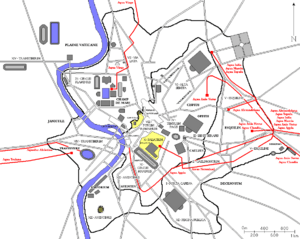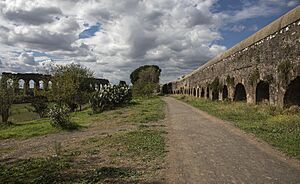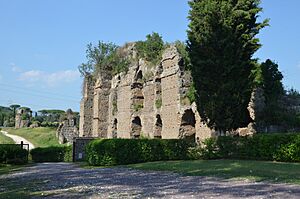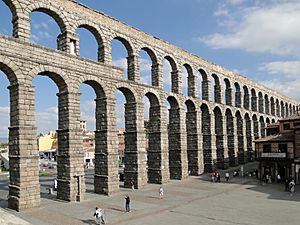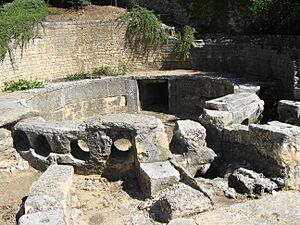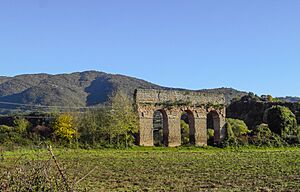Roman aqueduct facts for kids
The Romans built amazing structures called aqueducts all over their Republic and later their Empire. These aqueducts brought fresh water from far away into their cities and towns. This water was used for many things: public baths, toilets, fountains, and even private homes. It also helped with mining, grinding grain, farming, and watering gardens.
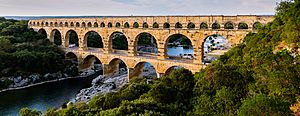
Aqueducts worked using only gravity. Water flowed downhill along a gentle slope inside channels made of stone, brick, concrete, or lead. The steeper the slope, the faster the water moved. Most of these channels were buried underground, following the shape of the land. If a hill was in the way, they would go around it or, less often, tunnel through it.
When there were valleys or low areas, the water channel would be carried on bridges (like the famous Pont du Gard). Sometimes, water was sent through high-pressure pipes made of lead, ceramic, or stone, using a system called a siphon to cross the low ground. Many aqueduct systems had special tanks to let dirt settle out of the water. Gates, distribution tanks (called castella aquae), and stopcocks helped control the water flow to different places. Any extra water could be stored in cisterns.
Laws and customs protected aqueducts and their water. Public fountains got water first, then public baths. Wealthy people who paid a fee got water after that. Some very rich citizens received free water as a special honor from the state. In cities, clean overflow water from aqueducts helped industries like fulling (cleaning cloth) and dyeing. It also helped mills that used water power. Used water and extra water flowed into gardens and cleaned the drains and public sewers. Farmers sometimes illegally took water from aqueducts for their crops, but this was rarely punished. It helped keep food prices low, and farming was very important to Rome's economy.
Rome's first aqueduct was built in 312 BC. It supplied a fountain in the city's cattle market. By the 3rd century AD, Rome had eleven aqueducts. These supported over a million people in a city that used a lot of water, especially for its many public baths. Cities and towns across the Roman Empire copied this idea. They built aqueducts as symbols of public pride. Most Roman aqueducts were strong and lasted a long time. Some were even used into modern times, and a few are still partly working today!
The Roman writer Vitruvius wrote about how aqueducts were surveyed and built in his book De architectura. A general named Frontinus gave even more details in his official report about Rome's public water supply, including its problems and how it was used. Famous aqueduct structures include the tall arches of the Aqueduct of Segovia and the aqueduct-fed cisterns in Constantinople.
Contents
How Romans Got Water Before Aqueducts
Before aqueducts, Romans, like most ancient people, got their water from local springs and streams. They also used groundwater from wells and collected rainwater from rooftops in storage jars and cisterns. These local water sources were used a lot throughout Roman history. However, relying only on nearby water limited how much the city could grow and how safe its water supply was. The River Tiber was close, but its water was often dirty and carried diseases.
Roman aqueducts weren't entirely new inventions. Roman engineers likely learned from the water systems of their Etruscan and Greek allies. But the Romans made aqueducts incredibly successful. By the early Roman Empire, Rome's aqueducts helped support over a million people. Having lots of water for public places became a key part of Roman life.
Rome's Waterways
Rome's main aqueducts and when they were finished:
- 312 BC Aqua Appia
- 272 BC Aqua Anio Vetus
- 144–140 BC Aqua Marcia
- 127–126 BC Aqua Tepula
- 33 BC Aqua Julia
- 19 BC Aqua Virgo
- 2 BC Aqua Alsietina
- 38–52 AD Aqua Claudia
- 38–52 AD Aqua Anio Novus
- 109 AD Aqua Traiana
- 226 AD Aqua Alexandrina
Rome likely needed more water than its local sources could provide by 312 BC. That's when the city's first aqueduct, the Aqua Appia, was ordered by a Roman official called a censor, Appius Claudius Caecus. This aqueduct was a big project, like a military road built at the same time. Most of the Aqua Appia was buried underground, making it safe from attacks. It brought water from a spring 16.4 km away, dropping 10 meters over its length. It delivered about 75,500 cubic meters of water daily to a fountain in Rome's cattle market.
About 40 years later, the Aqua Anio Vetus was built. It was paid for with treasures taken from Pyrrhus of Epirus. This aqueduct carried more than twice the water of the Aqua Appia and supplied higher parts of the city.
By 145 BC, Rome needed even more water. An official group found that the aqueduct channels were old and leaky, losing water. A Roman official named Quintus Marcius Rex fixed them. He also added a third, "healthier" water supply, the Aqua Marcia. This was Rome's longest aqueduct and was high enough to supply the Capitoline Hill. As the city grew, more aqueducts were built, like the Aqua Tepula in 127 BC and the Aqua Julia in 33 BC.
Aqueduct building really took off during the Roman Empire. Emperors took over the job of providing public water. Emperor Augustus oversaw the building of the Aqua Virgo and the shorter Aqua Alsietina. The Aqua Alsietina provided non-drinking water to the Trastevere area for gardens. It was also used to create an artificial lake for staged sea battles to entertain people. Emperor Caligula started two more aqueducts that his successor Claudius finished: the 69 km (42.8 mile) Aqua Claudia and the Anio Novus. The Aqua Claudia had good water but often broke down. The Anio Novus was the highest and most reliable, but its water could be muddy after rain, even with settling tanks.
Most of Rome's aqueducts got water from springs in the Anio valley, east of the Tiber River. A complex system of channels and tanks supplied water to every part of the city. The Trastevere area, west of the Tiber, got water from extensions of eastern aqueducts. These crossed the river using lead pipes buried under bridges, acting like an inverted siphon. If these pipes needed repairs, the "unhealthy" water from the Aqua Alsietina was used for Trastevere's public fountains. This problem was solved when Emperor Trajan built the Aqua Traiana in 109 AD, bringing clean water directly to Trastevere from Lake Bracciano.
By the late 3rd century AD, Rome had eleven state-funded aqueducts. Their total length was about 780 to 800 km. About 47 km of this was above ground on stone supports. Most of Rome's water came from four of these: the Aqua Anio Vetus, Aqua Marcia, Aqua Claudia, and Aqua Anio Novus. Experts estimate that Rome received between 520,000 and 1,000,000 cubic meters of water per day, supplying a population of about 1,000,000 people.
Aqueducts Across the Roman Empire

Hundreds of aqueducts were built throughout the Roman Empire. Many have fallen apart or been destroyed, but some parts still stand. The Zaghouan Aqueduct in modern Tunisia was 92.5 km long. It was built in the 2nd century AD to supply Carthage. Other surviving aqueduct bridges include the Pont du Gard in France and the Aqueduct of Segovia in Spain. The longest single aqueduct channel, over 240 km, was part of the Valens Aqueduct system in Constantinople. This was an amazing engineering feat for its time. Another very long and complex aqueduct was the Aqua Augusta in Italy. It supplied many fancy coastal homes of rich Romans, fish farms, gardens, vineyards, and at least eight cities, including the major ports of Naples and Misenum. Ships needed a lot of fresh water for their voyages.
Aqueducts were also built to supply Roman military bases in Britain. Permanent forts had fountains and piped water, likely from aqueducts starting around the time of Emperor Claudius. Smaller forts also got water from aqueducts, especially when they started having bathhouses.
Building and Managing Aqueducts
Planning the Route
Plans for any aqueduct had to be approved by city officials. Permission was only given if the plan respected other citizens' water rights. Sometimes, there were arguments and court cases over water, but generally, Roman communities tried to share water fairly. Planners preferred to build public aqueducts on public land. They tried to find the shortest, easiest, and cheapest route from the water source to the city. Buying private land or changing the route to avoid landowners could make the aqueduct much longer and more expensive.
In the countryside, a "clear corridor" was marked out along the aqueduct's path. This was usually 15 feet wide on each side of the channel, or 5 feet for lead pipes and in built-up areas. The channels and their foundations belonged to the state or emperor. These corridors were public land, allowing easy access for maintenance. Nothing was allowed in these corridors that could damage the aqueduct, like new roads, buildings, plowing, or trees. However, cutting hay and grass was allowed. These rules were important for keeping the aqueduct working, but they weren't always easy to enforce, especially when public land was seen as common property.
Finding Water and Surveying
Springs were the most common water sources for aqueducts. Most of Rome's water came from springs in the Anio valley. Spring water flowed into a stone or concrete springhouse, then into the aqueduct channel. If there were many scattered springs, several smaller channels would feed into a main one. Some systems also got water from large, purpose-built reservoirs, like the two (still in use) that supplied the aqueduct in the city of Emerita Augusta.
The land the aqueduct crossed had to be carefully surveyed. This made sure the water would flow at a steady and good speed for the whole distance. Roman engineers used special tools to map the aqueduct's path. They used a chorobates (a long wooden frame with a water level and plumb lines) to check horizontal levels. They used a groma and later a dioptra (like a modern theodolite) to plot angles and courses. In his book, Vitruvius wrote about how to find good water sources and test water for drinking.
Water Quality and Health
Greek and Roman doctors knew that dirty or still water could cause diseases. They thought rainwater was the purest and healthiest, followed by spring water. Rome's public baths, while great for hygiene, could also spread waterborne diseases. The writer Celsus warned that public bathing could cause infections in open wounds. Frontinus liked a lot of overflow in the aqueduct system because it helped keep the water supply and sewers cleaner.
Romans also knew about the harmful effects of lead on people who mined and worked with it. Ceramic pipes were preferred for drinking water because they didn't add anything to the water, unlike lead pipes. In some Roman areas, especially isolated communities, wooden pipes were used. Pliny suggested using pine and alder wood pipes because they lasted a long time when kept wet and buried. If lead pipes were used, the constant water flow and mineral deposits inside the pipes helped reduce lead contamination. The amount of lead in Rome's aqueduct water was measurable but probably not truly harmful. Still, it was 100 times higher than in local spring waters.
Channels and Slopes

Most Roman aqueducts had flat bottoms and arched tops, about 0.7 meters (2.3 feet) wide and 1.5 meters (5 feet) high inside. They usually ran 0.5 to 1 meter underground, with covers for inspection. Channels above ground usually had slab tops. Early channels were built with large, cut stones, but later, brick-faced concrete was often used. The concrete inside was usually waterproof and very smooth. Water flowed only by gravity. The amount of water depended on rainfall, the channel's size, and its slope. Most channels ran about two-thirds full. The channel's size also allowed workers to enter for maintenance.
Vitruvius suggested a very gentle slope, at least 1 in 4800, to prevent damage from erosion and water pressure. This matches the slopes found in existing aqueducts. The Pont du Gard has a slope of only 34 cm per km, dropping just 17 meters over its entire 50 km length. It could carry up to 20,000 cubic meters of water a day. Temporary aqueducts for mining could have much steeper slopes. Where steep slopes were unavoidable in permanent aqueducts, the channel could be stepped down or widened to slow the water and reduce its force. These steps also helped add oxygen to the water, making it "fresher."
Bridges, Siphons, and Tunnels
Some aqueduct channels crossed valleys or dips on tall arches made of stone, brick, or concrete. These are called arcades. The Pont du Gard is a famous example, spanning the Gardon river valley about 48.8 meters (160 feet) high. For very deep or long valleys, inverted siphons were used instead of arches. Water flowed into a header tank, then into pipes that crossed the valley at a lower level, often on a low bridge. The pipes then rose to a receiving tank at a slightly lower height. From there, the water flowed into another channel, keeping the overall downhill slope. Siphon pipes were usually made of soldered lead, sometimes strengthened with concrete or stone. Less often, they were stone or ceramic pipes sealed with lead.
Vitruvius described how to build siphons and the problems of blockages and high pressure at the lowest points. Still, siphons worked well if built and maintained properly. Modern engineers use similar methods for sewers and water pipes crossing low areas.
Some aqueducts in hilly areas used a mix of bridges, buried channels, and tunnels large enough for the channel and workers. For example, the Aqua Augusta in Campania changed the water's direction using a 6 km tunnel, several shorter tunnels, and bridges. It supplied many cities and villas along its route.
Checking and Fixing Aqueducts
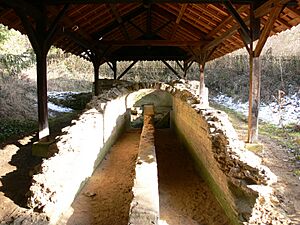
Roman aqueducts needed regular maintenance. Buried channels had inspection points so workers could find blockages or leaks. Water lost from small leaks in buried channels was hard to spot unless you tasted the fresh water, which was different from groundwater. The clear corridors around the aqueducts were regularly checked for illegal plowing, planting, roads, and buildings. Frontinus wrote that tree roots were especially damaging to the channels.
Workers would clean out algae, fix accidental breaks, remove gravel and debris, and scrape off calcium carbonate (a mineral deposit) from hard water sources. Even a little roughness from these deposits could slow the water flow by up to a quarter. Deposits in siphons could greatly reduce flow. In Rome, where water was hard, main pipes were buried shallowly under road curbs for easy access, as they needed frequent replacement due to calcium carbonate buildup.
Completely shutting down an aqueduct for repairs was rare and kept as short as possible, usually in winter when water demand was lowest. Water flow could be reduced or stopped at the castella for small repairs. But major repairs to the main channel needed the water to be diverted upstream, even at the spring source. Frontinus described using temporary lead pipes to carry water past damaged sections during repairs, so the supply wasn't completely lost.
The Aqua Claudia, one of Rome's biggest aqueducts, partly collapsed at least twice over two centuries. This was likely due to poor building, not enough money for repairs, neglect by emperors, illegal water taps, earthquakes, and damage from floods. Inscriptions say it was out of use for nine years before Emperors Vespasian and Titus restored it.
Water Distribution
Aqueduct main lines could be tapped directly, but usually, they fed into public distribution centers called castellum aquae ("water castles"). These acted as settling tanks and cisterns. From there, water went into various branches through lead or ceramic pipes. These pipes came in 25 standard sizes and had bronze stopcocks. The flow from each pipe could be fully or partly opened or shut off. Water could be sent to other parts of the system if needed.
Public basins and drinking fountains got water first, before public baths. A small fee was charged to use the public baths. Water for basins and baths was prioritized over water for private users who paid a fee. Private users were registered, and the size of their pipe determined how much water they got and how much they paid. Some properties could be bought with a legal right to draw water. Aqueduct officials could also give the right to use overflow water (aqua caduca) to certain people or groups. For example, fullers (who cleaned cloth) used a lot of fresh water and paid a fee for it. Some people received free overflow water as an honor from the state. Records show that about half of Rome's free water grants went to very wealthy citizens. These grants were given to specific people and couldn't be sold with a property or passed down. New owners had to get a new grant. However, these personal grants were often transferred anyway.
Frontinus believed that dishonest private users and corrupt state workers were responsible for most of the water loss and theft in Rome. His book De aquaeductu was a technical guide and a warning that he would catch anyone stealing water. He claimed to know how much was stolen and how it was done. Cheating was common. People would install illegal or extra taps, sometimes miles outside the city, or illegally widen their lead pipes. This often involved bribing aqueduct officials or workers. Archeological evidence confirms some illegal water use, but not how much water was lost. Water allowance was measured by the pipe's cross-sectional area at the supply point, but there was no way to account for changes in water speed or actual usage. One study suggests that about 17% of Rome's water went to the emperor (including his gifts), 38% to private individuals, and 45% to the public (including baths and fountains).
Management of Water Systems
In the Roman Republic, aqueducts were planned, built, and managed by censors or aediles. During the Empire, emperors took over this responsibility. Rome didn't have a permanent central group to manage aqueducts until Emperor Augustus created the office of water commissioner (curator aquarum). This was a very important job. In 97 AD, Frontinus, who had been a consul and general, served as both consul and curator aquarum under Emperor Nerva.
Some parts of the very long and complex Aqua Augusta in Campania were overseen by wealthy local officials called curatores. These officials were chosen by local voters or by Augustus himself. This entire water system relied on just two mountain springs, which also fed a river with freshwater fish, providing free food. The Augusta supplied eight or nine towns and many farms and villas, including bathhouses, through branch lines. Its ends were the naval port of Misenum and the merchant port of Puteoli. It's unlikely the water delivery was always perfect or without arguments.
Under Emperor Claudius, Rome's aqueduct workers (aquarii) included 460 people, both enslaved and free. They were paid by the emperor and from fees paid by private users. This group included "overseers, reservoir-keepers, line-walkers, pavers, plasterers, and other workmen," supervised by an Imperial freedman called the procurator aquarum. The curator aquarum had official powers over the water supply, helped by architects, public servants, scribes, and heralds. Outside the city, he even had two lictors to enforce his authority. There were big fines for breaking aqueduct laws. For example, 10,000 sesterces for letting a tree damage the channel, and 100,000 sesterces for polluting the water.
How Aqueducts Were Used
City and Home Use
Rome's first aqueduct (312 BC) delivered water at very low pressure to the city's main trading center and cattle market. It probably flowed into a series of basins. The upper basins were for household use, and the lower ones for watering livestock. Most Romans would fill buckets and jars at these basins and carry water home. Wealthier people would send their enslaved people to do this. The water outlet was too low to supply any homes directly. The overflow drained into Rome's main sewer and then into the Tiber River. Most people still relied on well water and rainwater. At this time, Rome had no public baths. The first one was likely built in the next century. Once aqueduct water reached higher parts of the city, large public baths and fountains were built everywhere. Public baths and fountains became key parts of Roman life, and baths became important social centers.
Most city Romans lived in multi-story apartment buildings (insulae). Some buildings offered water service, but only to tenants on the more expensive lower floors. Other tenants got their water for free from public fountains. During the Empire, lead production (mostly for pipes) became an imperial monopoly. The right to use water from state-funded aqueducts for private use became an imperial privilege. Providing free drinking water to the public was one of many gifts from the emperor to the people of Rome. In 33 BC, Marcus Agrippa built or helped pay for 170 public bath-houses. In Frontinus's time (around 40–103 AD), about 10% of Rome's aqueduct water went to 591 public fountains, including 39 fancy ones. By the late 4th century AD, Rome's aqueducts (19 of them) supplied 11 large public baths, 965 smaller public bathhouses, and 1,352 public fountains.
Farming Use
Between 65% and 90% of the Roman Empire's population worked in agriculture. Water was perhaps the most important thing for farming in the Mediterranean world. Roman Italy had many natural freshwater sources like springs, streams, rivers, and lakes in some places, but none in others. Rainfall was unpredictable. Water was often scarce when it was most needed during the warm, dry summer growing season. Farmers whose villas or estates were near a public aqueduct could get a specific amount of water for irrigation, with permission. They would use a bucket to take water from the channel through inspection hatches. This was meant to limit water loss for users further down the line and ensure fair distribution when water was most needed. The writer Columella said a farm should have a "never failing" spring, stream, or river, but he knew not all farms did.
Farmland without a reliable summer water source was almost worthless. During the growing season, a small local irrigation system could use as much water as the city of Rome. Livestock, whose manure fertilized the fields, needed water all year. Some Roman landowners and farmers relied partly or fully on aqueduct water to grow crops. The exact amount of aqueduct water used for farming is unknown. However, city aqueducts led to more intensive farming of delicate, perishable goods like flowers (for perfumes and garlands), grapes, vegetables, and fruits, as well as small animals like pigs and chickens, close to city markets.
Having permission to use aqueduct water for farming could increase crop production, bring in money from selling extra food, and raise the value of the land. In the countryside, it was hard to get permission to use aqueduct water for irrigation. There were many legal disputes and political campaigns about how these rights were used and abused. In 184 BC, Cato tried to stop all illegal rural water taps, especially those owned by wealthy landowners. This might be linked to Cato's complaints about an ex-consul who bought land cheaply and then channeled public water to it. Cato's efforts didn't last. Even though illegal tapping could lead to losing land and crops, this law was rarely used. Water theft helped farmers, created food surpluses, and kept food prices low. Grain shortages could lead to hunger and social unrest. Any solution had to balance the water needs of cities with those of grain producers, tax the farmers' profits, and ensure enough grain for Rome's poor and the army. Instead of banning illegal taps, authorities gave out individual water grants and licenses, trying to regulate water use with mixed success. In the 1st century AD, Pliny the Elder, like Cato, complained about grain producers getting rich from public water and land.
Some landowners avoided these rules by buying water rights to distant springs, even if they weren't on their own land. A few very rich and powerful people built their own aqueducts to bring water from the source to their fields or villas. For example, Mumius Niger Valerius Vegetus bought rights to a spring and its water from his neighbor, then built an aqueduct almost 10 kilometers long to connect the spring to his villa.
Industrial Use

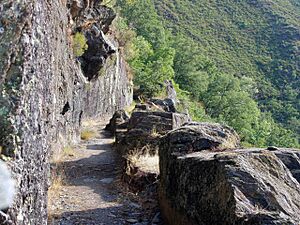
Some aqueducts supplied water to industrial sites, usually through open channels cut into the ground. These channels were lined with clay or wood to reduce water loss. Most of these channels were designed with steep slopes to deliver the large amounts of water needed for mining. Water was used in hydraulic mining to wash away the topsoil and expose ore. It also helped break up rock that had been heated and weakened by fire-setting. Water power also ran stamps and trip-hammers that crushed ore for processing. Evidence of these channels and machines has been found at Dolaucothi in south-west Wales.
Mining sites like Dolaucothi and Las Medulas in northern Spain show many aqueducts that brought water from local rivers to the mine. These channels might have worn out quickly or become useless once the nearby ore was gone. Las Medulas has at least seven such channels, and Dolaucothi has at least five. At Dolaucothi, miners used reservoirs, hushing tanks, and sluice gates to control water flow. They also used drop chutes to divert water. The remaining traces of these channels help us understand the mining process.
Other sites with several aqueducts haven't been fully explored yet. For example, at Longovicium near Lanchester, south of Hadrian's wall, water supplies might have powered trip-hammers for forging iron.
At Barbegal in Roman Gaul, a reservoir fed an aqueduct that powered a series of 15 or 16 water mills, grinding flour for the Arles region. Similar, smaller setups have been found in Caesarea, Venafrum, and Roman-era Athens. Rome's Aqua Traiana powered a flour mill at the Janiculum, west of the Tiber. A mill in the basement of the Baths of Caracalla was powered by aqueduct overflow. This was one of many city mills powered by aqueduct water, with or without official permission. A 5th-century law banned the illegal use of aqueduct water for milling.
Why Aqueducts Were Used Less
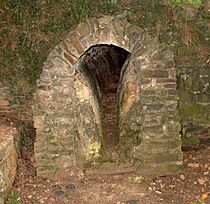
During the fall of the Western Roman Empire, some aqueducts were intentionally cut by enemies. In 537 AD, the Ostrogoths attacked Rome and cut off the city's aqueduct supply, including the aqueduct-powered grist-mills on the Janiculum. Belisarius, who defended the city, moved mills to the Tiber River instead. He also blocked the aqueduct channels to prevent the Ostrogoths from using them to get into the city. Over time, some of Rome's damaged aqueducts were partly fixed. However, the city's population was much smaller and poorer. Most aqueducts slowly fell apart because they weren't maintained. This created swamps and marshes where they broke. By the late Middle Ages, only the Aqua Virgo still provided a reliable supply, and Rome mostly relied on wells and rainwater cisterns.
In the provinces, most aqueducts stopped being used because Roman structures fell apart and weren't maintained, like the Eifel aqueduct (pictured right). A Spanish traveler named Pedro Tafur, who visited Rome in 1436, misunderstood how Roman aqueducts worked. He thought the Tiber River ran through the city in a new lead bed made by Romans!
During the Renaissance, the remains of Rome's huge stone aqueducts inspired architects and engineers. Pope Nicholas V renovated the main channels of the Roman Aqua Virgo in 1453. Many aqueducts in Rome's former empire were kept in good repair. The 15th-century rebuilding of an aqueduct at Segovia in Spain showed improvements over the Pont du Gard. It used fewer, taller arches, which saved materials. The skill of building aqueducts was not lost, especially for the smaller channels used to supply water wheels. Most such mills in Britain were built in the medieval period for making bread. They used similar methods to the Romans, with channels taking water from local rivers and streams.
See also
- List of Roman aqueduct bridges
- Roman architectural revolution
- Ancient Roman architecture
- Ancient Roman engineering
- Ancient Roman technology
- Roman concrete


